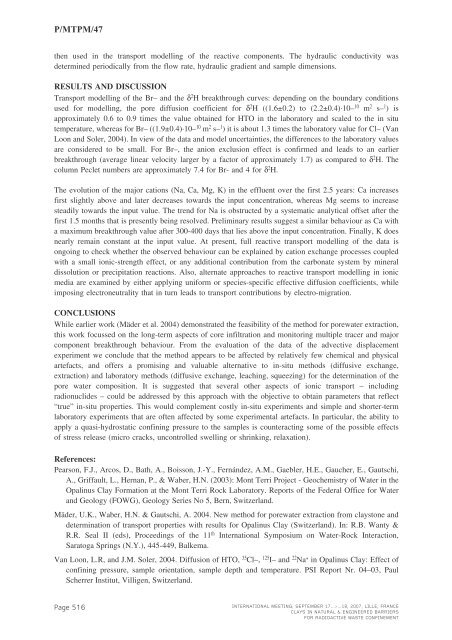Mass Transfer & Porous Media (MTPM) - Andra
Mass Transfer & Porous Media (MTPM) - Andra
Mass Transfer & Porous Media (MTPM) - Andra
Create successful ePaper yourself
Turn your PDF publications into a flip-book with our unique Google optimized e-Paper software.
P/<strong>MTPM</strong>/47then used in the transport modelling of the reactive components. The hydraulic conductivity wasdetermined periodically from the flow rate, hydraulic gradient and sample dimensions.RESULTS AND DISCUSSIONTransport modelling of the Br– and the δ 2 H breakthrough curves: depending on the boundary conditionsused for modelling, the pore diffusion coefficient for δ 2 H ((1.6±0.2) to (2.2±0.4)·10– 10 m 2 s– 1 ) isapproximately 0.6 to 0.9 times the value obtained for HTO in the laboratory and scaled to the in situtemperature, whereas for Br– ((1.9±0.4)·10– 10 m 2 s– 1 ) it is about 1.3 times the laboratory value for Cl– (VanLoon and Soler, 2004). In view of the data and model uncertainties, the differences to the laboratory valuesare considered to be small. For Br–, the anion exclusion effect is confirmed and leads to an earlierbreakthrough (average linear velocity larger by a factor of approximately 1.7) as compared to δ 2 H. Thecolumn Peclet numbers are approximately 7.4 for Br- and 4 for δ 2 H.The evolution of the major cations (Na, Ca, Mg, K) in the effluent over the first 2.5 years: Ca increasesfirst slightly above and later decreases towards the input concentration, whereas Mg seems to increasesteadily towards the input value. The trend for Na is obstructed by a systematic analytical offset after thefirst 1.5 months that is presently being resolved. Preliminary results suggest a similar behaviour as Ca witha maximum breakthrough value after 300-400 days that lies above the input concentration. Finally, K doesnearly remain constant at the input value. At present, full reactive transport modelling of the data isongoing to check whether the observed behaviour can be explained by cation exchange processes coupledwith a small ionic-strength effect, or any additional contribution from the carbonate system by mineraldissolution or precipitation reactions. Also, alternate approaches to reactive transport modelling in ionicmedia are examined by either applying uniform or species-specific effective diffusion coefficients, whileimposing electroneutrality that in turn leads to transport contributions by electro-migration.CONCLUSIONSWhile earlier work (Mäder et al. 2004) demonstrated the feasibility of the method for porewater extraction,this work focussed on the long-term aspects of core infiltration and monitoring multiple tracer and majorcomponent breakthrough behaviour. From the evaluation of the data of the advective displacementexperiment we conclude that the method appears to be affected by relatively few chemical and physicalartefacts, and offers a promising and valuable alternative to in-situ methods (diffusive exchange,extraction) and laboratory methods (diffusive exchange, leaching, squeezing) for the determination of thepore water composition. It is suggested that several other aspects of ionic transport – includingradionuclides – could be addressed by this approach with the objective to obtain parameters that reflect“true” in-situ properties. This would complement costly in-situ experiments and simple and shorter-termlaboratory experiments that are often affected by some experimental artefacts. In particular, the ability toapply a quasi-hydrostatic confining pressure to the samples is counteracting some of the possible effectsof stress release (micro cracks, uncontrolled swelling or shrinking, relaxation).References:Pearson, F.J., Arcos, D., Bath, A., Boisson, J.-Y., Fernández, A.M., Gaebler, H.E., Gaucher, E., Gautschi,A., Griffault, L., Hernan, P., & Waber, H.N. (2003): Mont Terri Project - Geochemistry of Water in theOpalinus Clay Formation at the Mont Terri Rock Laboratory. Reports of the Federal Office for Waterand Geology (FOWG), Geology Series No 5, Bern, Switzerland.Mäder, U.K., Waber, H.N. & Gautschi, A. 2004. New method for porewater extraction from claystone anddetermination of transport properties with results for Opalinus Clay (Switzerland). In: R.B. Wanty &R.R. Seal II (eds), Proceedings of the 11 th International Symposium on Water-Rock Interaction,Saratoga Springs (N.Y.), 445-449, Balkema.Van Loon, L.R, and J.M. Soler, 2004. Diffusion of HTO, 35 Cl–, 125 I– and 22 Na + in Opalinus Clay: Effect ofconfining pressure, sample orientation, sample depth and temperature. PSI Report Nr. 04–03, PaulScherrer Institut, Villigen, Switzerland.Page 516INTERNATIONAL MEETING, SEPTEMBER 17...>...18, 2007, LILLE, FRANCECLAYS IN NATURAL & ENGINEERED BARRIERSFOR RADIOACTIVE WASTE CONFINEMENT
















